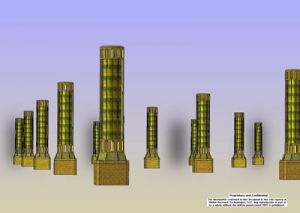This article is more than 1 year old
Obama science chief: Geo-engineer to save Gaia!
Sulphur, so good
If we can develop the scientific knowledge needed to change the climate for the benefit of humanity, and change it in a controlled manner, shouldn't we be trying to do it? Is it so different from developing antibiotics? Remarks this week by Obama's chief science advisor John Holdren have reopened the debate.
Holdren says he's open to advancing large-scale geo-engineering to cool the atmosphere, as a "last resort" response to Global Warming. Holdren specifically mentioned two approaches - seeding the atmosphere with aerosols, and building CO2 absorption towers, or "artificial trees".
"We don't have the luxury ... of ruling any approach off the table," said Holdren on a media tour this week.
One plan involves spraying aerosols such as sulphur into the upper atmosphere, replicating the cooling effect of volcanoes. Aerosols could be a quick fix to cool temperatures, and no one disputes that volcanoes cool the climate - but the level of scientific enquiry is so low it wouldn't look out of place in Dilbert's Elbonia.
As we discussed in a must-read article here, the IPCC estimates that the net effect of particulate matter is to cool the atmosphere by over .5W per square meter, although their error bar is greater than their guesstimate - and the IPCC admits the level of scientific understanding of aerosol feedbacks is "low". Climate science has barely begun to understand cloud formation, which is either ignored or fudged in today's GCM (General Circulation Model), the computer simulations used to produce scary predictions of Thermageddon.

But sulphur could certainly do the job - and it puts a whole new perspective on the environmentalist crusade against coal. By building two new sulphur-emitting coal-fired power stations a week, China is already doing the right thing - rapidly advancing the well-being of its population with cheap energy... and fighting Global Warming!
Artificial CO2 trees are more controversial. Advanced by Columbia University's Professor Klaus Lackner, who demonstrated a prototype five years ago, the "trees" are really carbon capture towers.

Lovely: a beautiful forest of artificial trees.
They're expensive and ugly compared to the natural alternative proposed by Freeman Dyson: planting real trees, genetically modified to absorb more carbon.
"If one-quarter of the world’s forests were replanted with carbon-eating varieties of the same species, the forests would be preserved as ecological resources and as habitats for wildlife, and the carbon dioxide in the atmosphere would be reduced by half in 50 years," wrote Dyson last year.
When Lackner testified to Parliament last year, he turned out to be one of the most sceptical:
"We should learn about it and we should have it ready in case we need it, but I would very much view that as an effort of last resort. We cannot solve the problem. We cannot stop the CO2 from accumulating by changing the climate and I would argue that this is such a complex system that you really do not want to do that unless you really have no choice left," Lackner told the education select committee. "You should not think of this as the way you stabilise the system."
The inference is that adaptation to climate change - pocketing the many benefits and spreading the costs over many years - is the most cost-effective solution, the one least likely to damage the economy, and the one least likely to limit personal freedom. It's also, given the collapse of resources available to the state following the bank bail out, probably the only one we can afford.
Anti-science groups such as Greenpeace don't agree, and nor do some climate sceptics, who can be their own worst enemies. Quoted in the Graun, a Greenpeace spokesman caused it "outlandish" and compared it to the "pressing the panic button". He found an unexpected ally in junk science critic Steve Milloy, normally a scourge of greenies. Milloy described it a plan to "blot out the sun", adding - "I sure hope plants and people don’t need those rays for say, photosynthesis or vitamin D production, respectively. And what would be the other unintended consequences?"
But if, as Lackner says, our level of scientific understanding is minimal, the way to remedy this is to do more science - not retreat to a cave and create superstitious fantasies. ®
Bootnote: In 1977 Holdren co-authored a book with neo-Malthusian Paul Erlich, which advocated the establishment of a global authority (a "Comprehensive Planetary Regime") to regulate international trade and consumption, redistribute wealth, and decide how many children people would be permitted to have in each region of the world. He doesn't seem quite so keen on it now.
